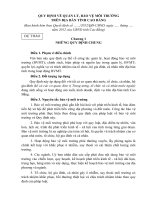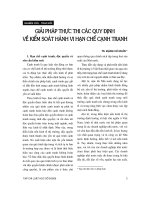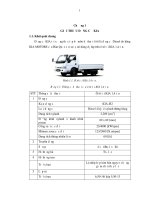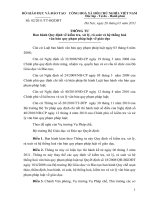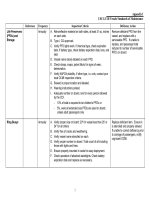QUY ĐỊNH VỀ KIỂM TRA BẢO DƯỠNG TRANG THIẾT BỊ CỨU SINH
Bạn đang xem bản rút gọn của tài liệu. Xem và tải ngay bản đầy đủ của tài liệu tại đây (111.35 KB, 7 trang )
Government of Bermuda
Department of Maritime Administration
2012-016
BERMUDA SHIPPING NOTICE
Servicing and Testing of Life-Saving Appliances, their release and
retrieval systems including On-load Release Hooks, Guidance on Freefall Lifeboats and Fall Preventer Devices
This notice is intended for Ship Owners, Managers, Masters and Officers, Surveyors, authorised
Classification Societies and applicable Service Companies, and applies to all vessels.
The notice supersedes Bermuda Circulars ROSC.23, 27 and 28 which have now been withdrawn.
Summary
This notice should be read in conjunction with:
Merchant Shipping Act 2002 as amended
Merchant Shipping (Life-saving Appliance for Ships Other Than Ships of Classes III to VI (A)) Regulations
1999 as amended
Safety Of Life At Sea (SOLAS) Chapter III as amended
This notice provides information from the 89th session of the IMO Maritime Safety Committee (MSC 89) held
in May 2011 where a number of amendments to Chapter III of SOLAS were adopted affecting lifeboat release
systems. The Committee also adopted several guidelines on the subject. This notice also sets out the scope of
the changes – which will affect both existing ships and new ships, and will require action by shipowners and
managers in the near future. The notice provides for:
•
•
•
•
•
•
1.
Requirements for Annual Inspection and testing of Life Saving Appliances and release and retrieval
systems
Authorised Service providers for Lifeboats, launching appliances and on-load release gear
Five Yearly overhaul and 110% dynamic testing
Servicing of Inflatable Life-rafts, Inflatable Boats, Rescue Boats, Fast Rescue Boats, Inflatable
Lifejackets and Hydrostatic Releases
Guidance on Drills involving Free Fall Lifeboats
Notes on Fall Preventer Devices
Requirements for annual inspection and testing of life saving appliances and release and retrieval systems
Launching appliances are required by SOLAS Chapter III, regulation 20.11 to be maintained on board in accordance
with the instructions for on-board maintenance. They are subjected to an annual thorough examination by an
authorised service provider and every five years or when the release gear is overhauled, to a dynamic test at 110% of
full load by an authorised service provider.
The requirement for the annual thorough examination includes a dynamic test of the brake mechanism at full
lowering speed with the full weight of the boat and equipment but without persons.
Page 1 of 7
The annual thorough examination and test should to be completed at the annual Cargo Ship Safety Equipment
survey or the Passenger Ship Safety survey as appropriate. The Department of Maritime Administration (DMA)
will accept evidence of the examination and test having been completed within the 3 month “window” before the
due date of the safety equipment survey. In each case the records and reports of the examination and test should be
available on board for the surveyor conducting the survey for his verification.
The full details of the scope of the annual thorough examination and test are contained in MSC.1/Circ.1206/Rev.1
dated 11 June 2009.
2.
Authorised Service providers for lifeboats, launching appliances and on-load release gear.
The conducting of Cargo Ship Safety Equipment surveys on Bermuda ships is delegated to the 7 Classification
Societies recoginsed by the Bermuda Administration. For the annual and five yearly examinations and tests on the
above appliances for cargo ships the authorised service provider should be a company which is authorised by either
an IMO “White Listed” Flag State or by a classification society.
Where the manufacturer of the equipment is no longer in business or no longer providing technical support the use
of Independent Lifeboat Servicing and Testing organisations can be permitted where they have suitable experience
of similar equipment. Additionally organisations included in the UK’s approved list of Independent Lifeboats
Servicing and Testing Organisations (ILSTO) can be used. In cases of doubt reference can be made to the
Administration.
The conducting of Passenger Ship Safety surveys remains the responsibility of the Maritime Administration. For
passenger ships it will be necessary to show that the organisation conducting the annual thorough examination and
tests including the 5 yearly tests is approved by the manufacturer of the above equipment for this purpose, and is
accepted as per the paragraph above.
3.
Five yearly overhaul and 110% dynamic testing.
In addition to the annual thorough examination and test, SOLAS requires that the on-load release and retrieval
system is overhauled every five years and the launching appliance and the release system is dynamically tested at
110% of full load.
The overhaul of the on-load release and retrieval system should be carried out by an authorised service provider for
the make of system in use.
In general these tests should be witnessed by either a Bermuda surveyor, a Classification Society surveyor or
another person authorised by the Marine Administration for this purpose.
It is recommended that the weight of the lifeboat with its fuel, stores and equipment, is checked before the test.
Recent tests have shown that some boats have a considerable increase in weight since manufacture.
The test may be conducted by loading the boat in its swung out position with water bags or equivalent to achieve the
computed 110% loading and then completing the test, or it may be done by testing the boat and hooks separately
from the launching appliances.
If the former method is used, the loading of the boat should be undertaken with great care ensuring that no person
enters the boat in the final stages of loading. The loaded boat is then allowed to drop at full speed and the brake is
suddenly applied. If space permits the test is repeated and the boat then lowered to a point where the keel is just
Page 2 of 7
touching the water. In this position, personnel can board the boat and operate the on-load release system. This test
should show the release of both hooks simultaneously.
If the boat and launching appliance are to be tested separately it will be necessary to provide equipment that can
simulate the full computed 110% load divided between the two hooks equally and show that both hooks release
simultaneously under that full load. For the launching appliance, the procedure is the same as for the loaded boat
but it can be done using water bags or similar, and a strain gauge or equivalent to measure the applied load.
In each case the attending surveyor witnessing the test should complete an examination of the equipment following
the test and if satisfied he should issue a certificate stating the loads used and the results of the test.
4.
Servicing Of Inflatable Life-rafts, Inflatable Boats, Rescue Boats, Fast Rescue Boats, Inflatable
Lifejackets and Hydrostatic Releases
4.1 Introduction
4.1.1
•
Under the provisions of the following Regulations, all inflatable life-rafts, boats, rescue boats, fast
rescue boats, inflatable lifejackets and hydrostatic release units carried on Bermuda registered ships are
required to be regularly serviced at an approved service station:
Regulation 11(7) of the Merchant Shipping (Life-Saving Appliances for Passenger Ships of Classes III to
VI (A)) Regulations 1999
4.2 Approved Service Stations
4.2.1
Equipment listed in paragraph 4.1.1 should be serviced annually by an approved service station, and
every effort should be made to ensure that it is carried out. In circumstances where it is impracticable
to comply with the annual servicing requirement, the servicing may be deferred for a period not
exceeding 5 months, as per SOLAS Chapter III, Regulation 20.8.1. In such cases, masters or owners
should apply for an extension to the DMA explaining the reason in writing for seeking deferment.
4.2.2
An 'approved service station' is formally appointed by the manufacturer of a Life-raft, boat or
inflatable lifejacket and has been accepted by the DMA. It has certificated personnel who have been
trained to undertake servicing and repairs, and also to repack inflatable life-rafts ready for operational
use. It carries genuine spares and is kept fully informed of the current servicing procedures by the
approved manufacturer.
4.2.3
At every biennial servicing or servicing referred to in paragraph 4.3.1, of a davit launched inflatable
life-raft, inflatable boat or inflatable rescue boat, a 10% overload static load test is to be carried out
with the life-raft or boat suspended from its lifting hook or bridle, in accordance with the
manufacturer’s approved servicing instructions.
4.3 Exceptions
4.3.1
The DMA may except a particular equipment from the annual servicing requirement and accept
servicing intervals up to 30 months, provided,
a) The equipment is specially packed, and,
b) Special packing systems have been designed and developed by the relevant manufacturers, and
these ensure that the life-rafts can;
(i) Be operated using the normal control lines, and,
Page 3 of 7
(ii) Remain protected throughout the extended servicing interval within a hermetically sealed
membrane which resists water vapour transmission.
Under the provisions of SOLAS 1974 Chapter III, regulations 20.8.3 and 20.8.5, the DMA has notified
IMO of the arrangements accepted on Bermuda Registered ships.
4.4. Hydrostatic Release Units (HRUs)
4.4.1
There have been incidences of incorrectly installed HRUs resulting in a compromise of the float-free
arrangements of the life-raft. After servicing of the life-raft and HRUs, they should be installed strictly
in accordance with the approved manufacturer's instructions. Details of the correct installation
procedure of the HRU to the life-raft should be provided with each unit supplied. Requirements for
onboard stowage of inflatable life-rafts together with hydrostatic release units are contained in the UK
Marine Guidance Note MGN 343 (M+F).
4.5 Marking of Stowage of LSA
4.5.1
Containers, brackets, racks, and other similar stowage locations for life-saving equipment, shall be
marked with symbols in accordance with the recommendations of the Organization indicating the
devices stowed in that location for that purpose. If more than one device is stowed in that location, the
number of devices shall also be indicated.
4.6 Other Information
4.6.1
Internationally, through the provisions of SOLAS 1974, National Administrations are responsible for
the approval of servicing stations for inflatable LSA located within their jurisdictions irrespective of
whether or not that particular administration has approved the subject product.
Page 4 of 7
GUIDANCE ON THE DRILLS INVOLVING FREE-FALL LIFEBOATS
1.0
There has been a recent amendment to SOLAS Chapter III, Regulation 19.3.3.4, as a result the
requirements for the testing of free-fall lifeboats have been changed. This change is reflected in the
amended paragraph of the above regulation as follows.
SOLAS Chapter III, Part B, Regulation 19.3.3.4 states:
“In the case of a lifeboat arranged for free-fall launching, at least once every three months during an
abandon ship drill the crew shall board the lifeboat, properly secure themselves in their seats and
commence the launch procedure up to but not including the actual release of the lifeboat (i.e., the release
hook shall not be released). The lifeboat shall then either be free-fall launched with only the required
operating crew on board, or lowered into the water by means of the secondary means of launching without
the operating crew on board. In both cases the lifeboat shall thereafter be maneuvered in the water by the
operating crew. At intervals of not more than six months, the lifeboat shall either be launched by free-fall
with only the operating crew on board, or simulated launching shall be carried out in accordance with the
guidelines developed by the Organization.”
2.0
In view of the above the Bermuda Administration requires the following:
2.1
Abandon ship drills shall be conducted each month in accordance with the equipment manufacturer’s
instructions so that all persons who enter a boat in an emergency are trained to embark the boat, to take
their seats in a correct way, to use the safety belts and are instructed on how to act during launching into the
sea; and
2.2
Free-fall Lifeboat equipped for simulated launching
2.2.1
On the third and ninth month, during abandon ship drills, a simulated launch shall be carried out with the
operating crew on board in accordance with the provisions of the Appendix to MSC 1206; and
2.2.2
On the sixth month, the lifeboat shall be lowered to the water without personnel on board, then manned by
the operating crew and maneuvered in the water; or
2.3
Free-fall Lifeboat NOT equipped for simulated launching
2.3.1
On the third, sixth and ninth month, during abandon ship drills, the lifeboat should be lowered to the water
without personnel on board, then manned by the operating crew and maneuvered in the water; and
2.4
All Free-fall Lifeboats:
At the twelfth month, ALL free-fall lifeboats shall be released to free-fall with the minimum operating crew
on board in accordance with the provisions of the Annex 2 of MSC 1206, and then maneuvered in the
water.
Page 5 of 7
THE FOLLOWING TABLES WILL ASSIST IN INTERPRETING THE ABOVE INFORMATION
Freefall Lifeboat equipped for Simulated Launching
Monthly
The Crew shall be:
shown how to embark the boat
X
shown how to take their seats in the
X
correct way,
shown how to use the safety belts
X
instructed on how to act during
X
launching into the sea
Simulated Launch carried out with
operating crew
Boat lowered to water without crew
onboard then manned by operating
crew and maneuvered in water
Released to free fall with minimum
operating crew onboard
3 months
6 months
9 months
12 months
X
X
X
X
X
X
X
X
X
X
X
X
X
X
X
X
X
X
X
X
Freefall Lifeboat NOT equipped for Simulated Launching
Monthly
3 months
The Crew shall be:
shown how to embark the boat
X
X
shown how to take their seats in the
X
X
correct way,
shown how to use the safety belts
X
X
instructed on how to act during
X
X
launching into the sea
Boat lowered to water without crew
X
onboard then manned by operating
crew and maneuvered in water
Released to free fall with minimum
operating crew onboard
6 months
9 months
12 months
X
X
X
X
X
X
X
X
X
X
X
X
X
X
X
Standard Lifeboats
Lifeboat turned out from stowed
position, without persons onboard to
demonstrate satisfactory operation
(Cargo ships)
Lifeboat turned out from stowed
position, without persons onboard to
demonstrate satisfactory operation (All
ships)
Lifeboat launched and maneuvered in
water with operating crew (All ships)
Weekly
X
Monthly
3 months
6 months
9 months
12 months
X
X
X
X
X
Page 6 of 7
FALL PREVENTER DEVICES (FPD’s)
For guidance on FPD’s please refer to the UK Marine Guidance Note MGN 445 (M+F), a summary of which is
contained below.
New requirements from the International Maritime Organization (IMO), have introduced standards for all Lifeboat
Release and Retrieval Systems (LRRS), including those installed on existing ships.
Existing systems that do not comply with the revised LSA Code as per SOLAS III/1.5 must be replaced by the first
scheduled dry-docking after 1 July 2014, and not later than 1 July 2019.
The DMA strongly urges that all Bermuda vessels fitted with lifeboat on-load release systems be fitted with fall
preventer devices (FPD) pending the evaluation of the systems for compliance with the requirements of the revised
LSA Code.
Prior to the fitting FPD’s, the original approving authority of the launching gear should be consulted to ascertain
whether the fitting of FPD’s to the approved launching gear is acceptable.
This notice is only applicable to davit-launched lifeboats fitted with on-load release hooks. FPDs should be fitted in
accordance with MSC.1/Circ.1327 ‘Guidelines for the fitting and use of fall preventer devices (FPDs)’.
More Information
Department of Maritime Administration
3rd Floor, Global House
43 Church Street
Hamilton, HM12
Bermuda
Tel: +1 441 295 7251
Fax: +1 441 295 3718
e-mail:
Page 7 of 7
